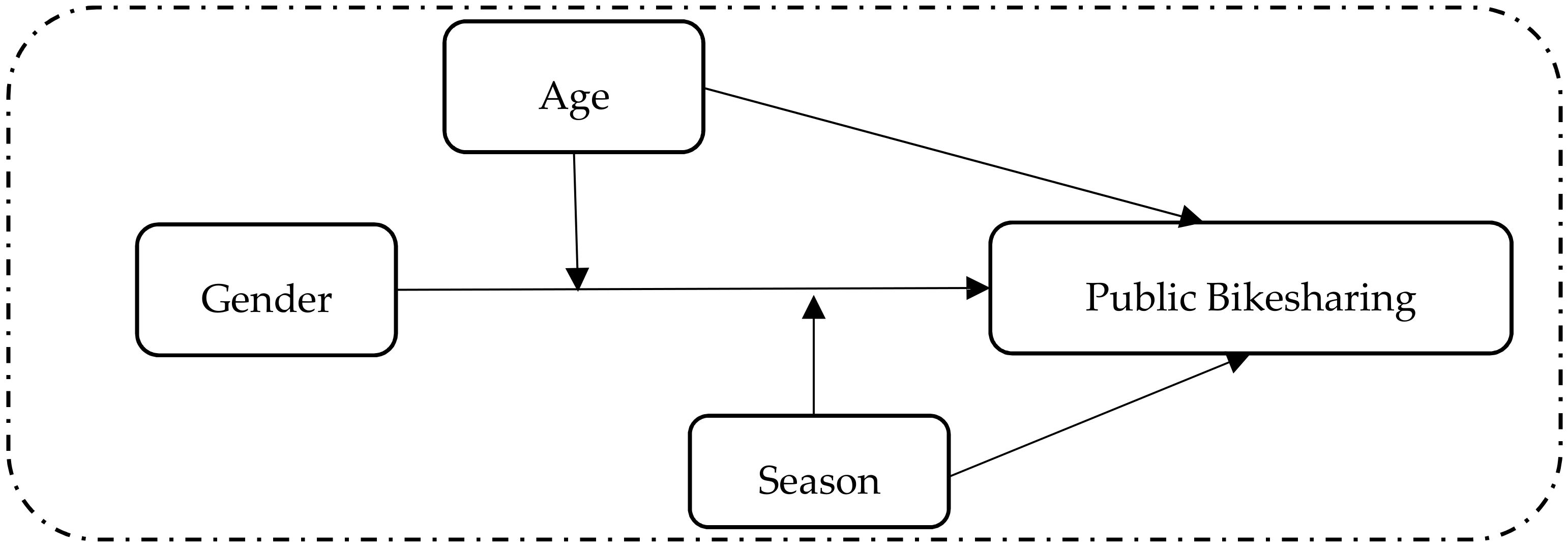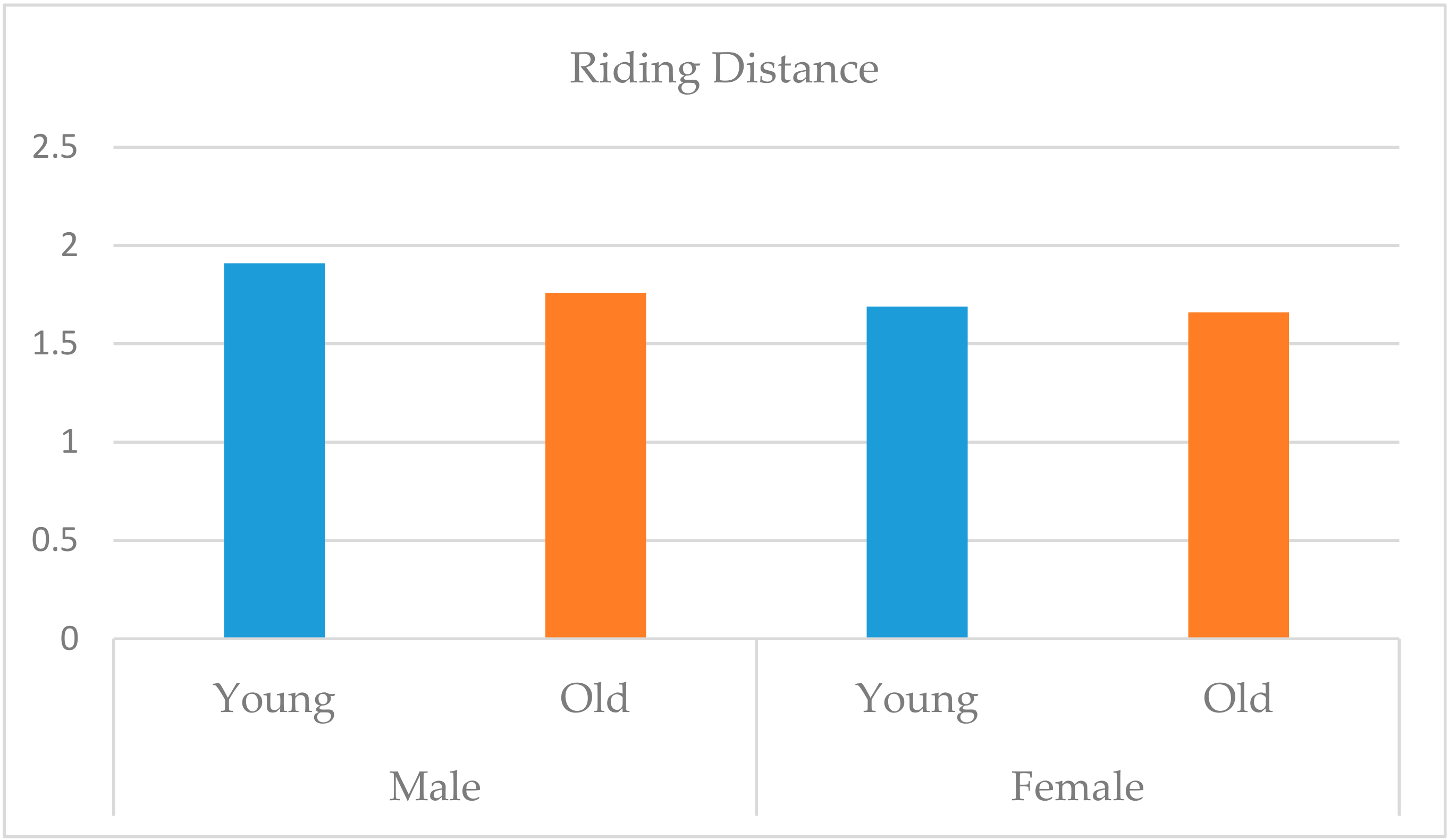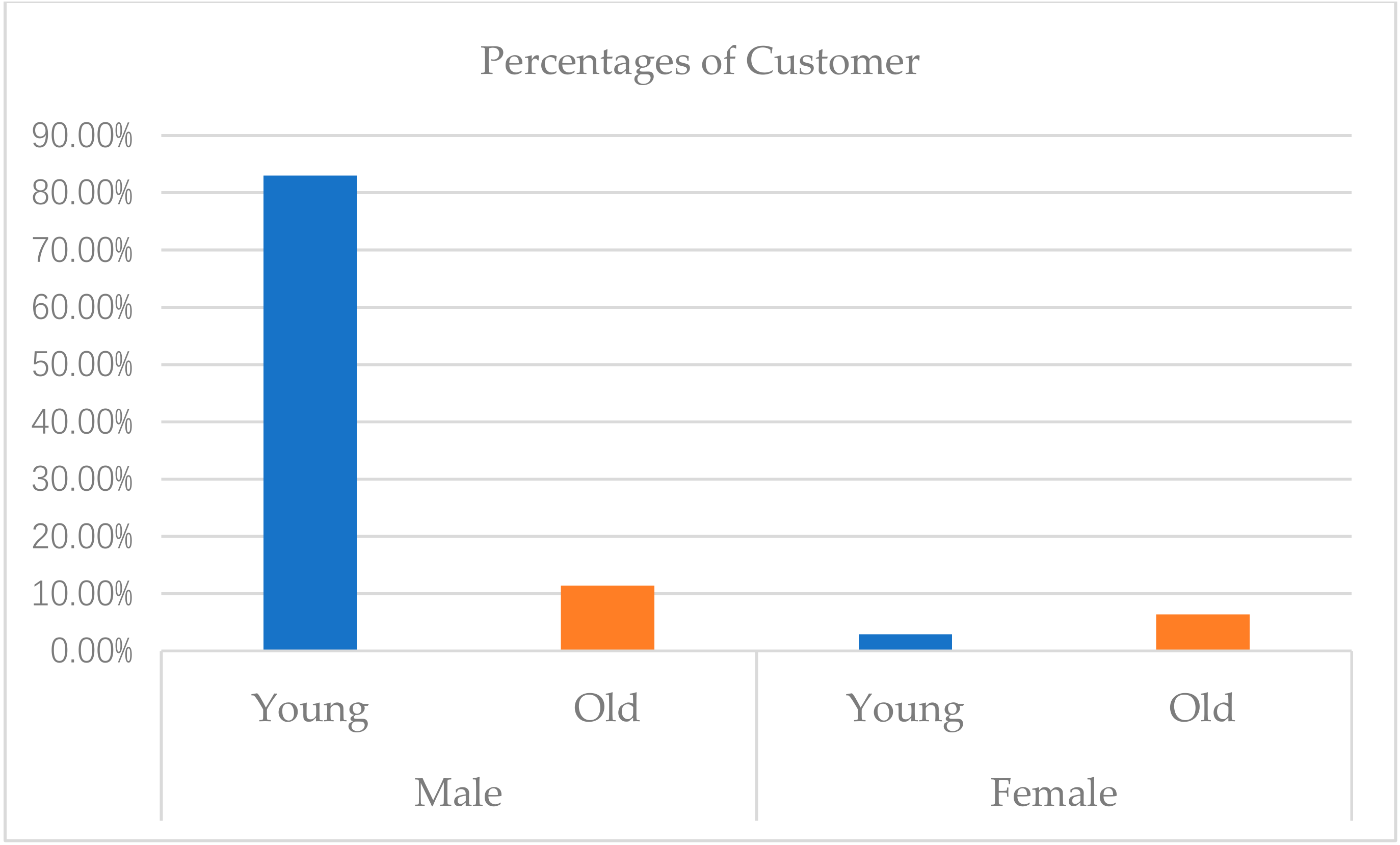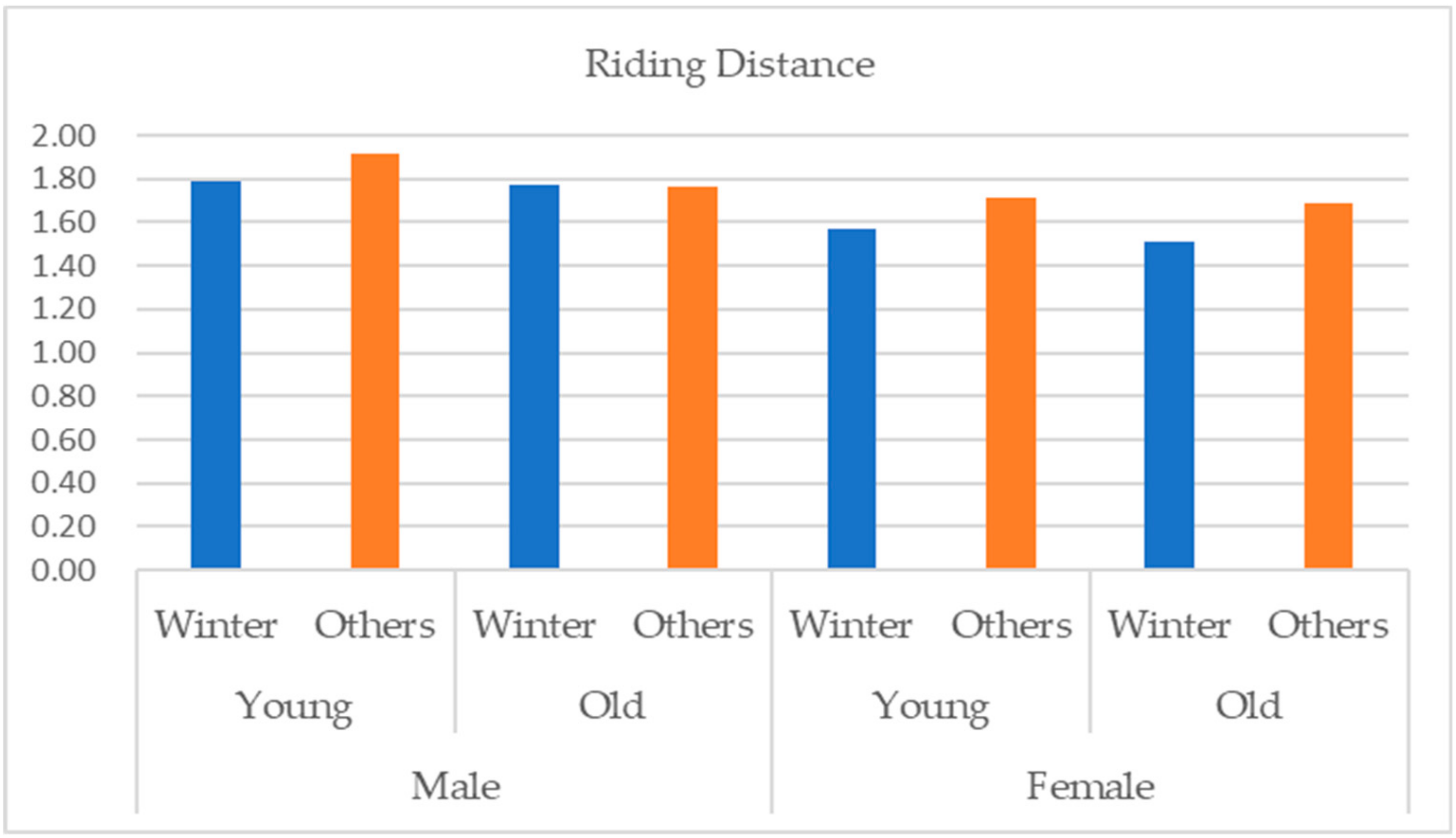Winter Sabotage: The Three-Way Interactive Effect of Gender, Age, and Season on Public Bikesharing Usage
Abstract
1. Background
2. Literature Review
3. Theoretical Framework and Hypotheses
4. Methods
4.1. Sample Descriptions
4.2. Measures
4.3. Hypothesis Test
4.4. Additional Analyses
5. Discussion
5.1. Theoretical Contributions
5.2. Policy Implications
5.3. Limitations
6. Conclusions
Author Contributions
Funding
Conflicts of Interest
References
- Hendriksen, I.J.; Simons, M.; Garre, F.G.; Hildebrandt, V.H. The association between commuter cycling and sickness absence. Prev. Med. 2010, 51, 132–135. [Google Scholar] [CrossRef] [PubMed]
- Kjellstrom, L.; van Kerkhoff, G.; Bammer, G.; McMichael, T. Comparative assessment of transport risks—How it can contribute to health impact assessment of transport policies. Bull. WHO 2003, 81, 451–457. [Google Scholar] [PubMed]
- Martin, E.W.; Shaheen, S.A. Evaluating public transit modal shift dynamics in response to bikesharing: A tale of two US cities. J. Transp. Geogr. 2014, 41, 315–324. [Google Scholar] [CrossRef]
- Parkes, S.D.; Marsden, G.; Shaheen, S.A.; Cohen, A.P. Understanding the diffusion of public bikesharing systems: Evidence from Europe and North America. J. Transp. Geogr. 2013, 31, 94–103. [Google Scholar] [CrossRef]
- Shaheen, S.A.; Cohen, A.P.; Martin, E.W. Public bikesharing in North America: Early operator understanding and emerging trends. Transp. Res. Rec. 2013, 2387, 83–92. [Google Scholar] [CrossRef]
- Wagner, A.; Simon, C.; Ducimetiere, P.; Montaye, M.; Bongard, V.; Yarnell, J.; Evans, A. Leisure-time physical activity and regular walking or cycling to work are associated with adiposity and 5 y weight gain in middle-aged men: The PRIME Study. Int. J. Obes. 2001, 25, 940–948. [Google Scholar] [CrossRef] [PubMed]
- Buehler, T.; Handy, S. Fifty years of bicycle policy in Davis, California. Transp. Res. Rec. 2008, 2074, 52–57. [Google Scholar] [CrossRef]
- Gleason, R.; Miskimins, L. Exploring Bicycle Options for Federal Lands: Bike Sharing, Rentals and Employee Fleets (No. FHWA-WFL/TD-12-001). 2012. Available online: http://www.nps.gov/transportation/pdfs/FHWA_bicycle_options.pdf (accessed on 10 May 2019).
- Institute for Transportation and Development Policy. Riding the Bike-Share Boom: The Top Five Components of a Successful System. 2013. Available online: http://www.itdp.org/riding-the-bike-share-boom-the-top-five-components-of-a-successful-system (accessed on 10 May 2019).
- Dill, J. Bicycling for transportation and health: The role of infrastructure. J. Public Health Policy 2009, 30, 95–110. [Google Scholar] [CrossRef] [PubMed]
- Shaheen, S.A.; Guzman, S.; Zhang, H. Bikesharing in Europe, the Americas, and Asia: Past, present, and future. Transp. Res. Rec. 2010, 2143, 159–167. [Google Scholar] [CrossRef]
- Hendriksen, I.J.; Zuiderveld, B.O.B.; Kemper, H.C.; Bezemer, P.D. Effect of commuter cycling on physical performance of male and female employees. Med. Sci. Sports Exerc. 2000, 32, 504–510. [Google Scholar] [CrossRef]
- Lin, J.R.; Yang, T.H. Strategic design of public bicycle sharing systems with service level constraints. Transp. Res. Part E Logist. Transp. Rev. 2011, 47, 284–294. [Google Scholar] [CrossRef]
- Nair, R.; Miller-Hooks, E.; Hampshire, R.C.; Bušić, A. Large-scale vehicle sharing systems: Analysis of Vélib’. Int. J. Sustain. Transp. 2013, 7, 85–106. [Google Scholar] [CrossRef]
- Sun, Y.; Mobasheri, A.; Hu, X.; Wang, W. Investigating impacts of environmental factors on the cycling behavior of bicycle-sharing users. Sustainability 2017, 9, 1060. [Google Scholar] [CrossRef]
- Sallis, J.F.; Conway, T.L.; Dillon, L.I.; Frank, L.D.; Adams, M.A.; Cain, K.L.; Saelens, B.E. Environmental and demographic correlates of bicycling. Prev. Med. 2013, 57, 456–460. [Google Scholar] [CrossRef] [PubMed]
- Fuller, D.; Gauvin, L.; Kestens, Y.; Daniel, M.; Fournier, M.; Morency, P.; Drouin, L. Use of a new public bicycle share program in Montreal, Canada. Am. J. Prev. Med. 2011, 41, 80–83. [Google Scholar] [CrossRef] [PubMed]
- Fuller, D.; Gauvin, L.; Kestens, Y.; Daniel, M.; Fournier, M.; Morency, P.; Drouin, L. Impact evaluation of a public bicycle share program on cycling: A case example of BIXI in Montreal, Quebec. Am. J. Public Health 2013, 103, 85–92. [Google Scholar] [CrossRef] [PubMed]
- Borecki, N.; Darren, B.; Payton, C.; Patricia, H.; Nicholas, K.; Ralph, B. Virginia Tech Capital Bikeshare Study. 2012. Available online: https://ralphbu.files.wordpress.com/2012/01/vt-bike-share-study-final3.pdf (accessed on 10 April 2019).
- Hazen, B.; Overstreet, R.; Wang, Y. Predicting public bicycle adoption using the technology acceptance model. Sustainability 2015, 7, 14558–14573. [Google Scholar] [CrossRef]
- Beijing Municipal Government. The Plan of Constructing Harmonious, Advanced and Green Transportation. 2009–2015. Available online: http://zhengwu.beijing.gov.cn/ghxx/qtgh/t1066279.html (accessed on 10 May 2019). (In Chinese)
- Byrnes, J.P.; Miller, D.C.; Schafer, W.D. Gender differences in risk taking: A meta-analysis. Psychol. Bull. 1999, 125, 367–383. [Google Scholar] [CrossRef]
- Garrard, J.; Rose, G.; Lo, S.K. Promoting transportation cycling for women: The role of bicycle infrastructure. Prev. Med. 2008, 46, 55–59. [Google Scholar] [CrossRef]
- Rissel, C.E.; Garrard, J. Cycling for active transport and recreation in Australia: Status review and future directions. World Transp. Policy Pract. 2006, 13, 49–63. [Google Scholar] [CrossRef]
- Goldsmith, S. The National Bicycling and Walking Study case Study No. 1: Reasons Why Bicycling and Walking Are Not Being Used More Extensively as Travel Modes; FHWA Publication No. FHWA-PD-93-041; US Government Printing Office: Washington, DC, USA, 1992.
- Liu, Z.; Jia, X.; Cheng, W. Solving the last mile problem: Ensure the success of public bicycle system in Beijing. Procedia Soc. Behav. Sci. 2012, 43, 73–78. [Google Scholar] [CrossRef]
- LDA Consulting. Capital Bikeshare 2011 Member Survey Report; LDA Consulting: Washington, DC, USA, 2012. [Google Scholar]
- Cai, B.; Chai, L.; ShangGuan, W.; Wang, J. Research on Car Following Model Based on Cooperative Vehicle Infrastructure System. In Proceedings of the 2012 IEEE-APS Topical Conference on Antennas and Propagation in Wireless Communications (APWC), Cape Town, South Africa, 2–7 September 2012; IEEE: Piscataway, NJ, USA, 2012; pp. 1217–1220. [Google Scholar]
- Davidson, D.J.; Freudenburg, W.R. Gender and environmental risk concerns: A review and analysis of available research. Environ. Behav. 1996, 28, 302–339. [Google Scholar] [CrossRef]
- Solomon, L.S.; Tomaskovic-Devey, D.; Risman, B.J. The gender gap and nuclear power: Attitudes in a politicized environment. Sex Roles 1989, 21, 401–414. [Google Scholar] [CrossRef]
- Heinen, E.; Kamruzzaman, M.; Turrell, G. The public bicycle-sharing scheme in Brisbane, Australia: Evaluating the influence of its introduction on changes in time spent cycling amongst a middle-and older-age population. J. Transp. Health 2018, 10, 56–73. [Google Scholar] [CrossRef]
- Fishman, E.; Washington, S.; Haworth, N.; Watson, A. Factors influencing bike share membership: An analysis of Melbourne and Brisbane. Transp. Res. Part A Policy Pract. 2015, 71, 17–30. [Google Scholar] [CrossRef]
- Woodcock, J.; Tainio, M.; Cheshire, J.; O’Brien, O.; Goodman, A. Health effects of the London bicycle sharing system: Health impact modelling study. BMJ 2014, 348, 425. [Google Scholar] [CrossRef]
- Corcoran, J.; Li, T.; Rohde, D.; Charles-Edwards, E.; Mateo-Babiano, D. Spatio-temporal patterns of a Public Bicycle Sharing Program: The effect of weather and calendar events. J. Transp. Geogr. 2014, 41, 292–305. [Google Scholar] [CrossRef]
- Dill, J.; Carr, T. Bicycle commuting and facilities in major US cities: If you build them, commuters will use them. Transp. Res. Rec. 2003, 1828, 116–123. [Google Scholar] [CrossRef]
- Nankervis, M. The effect of weather and climate on bicycle commuting. Transp. Res. Part A Policy Pract. 1999, 33, 417–431. [Google Scholar] [CrossRef]
- Nelson, R.D. Wishing for good weather: A natural experiment in group consciousness. J. Sci. Explor. 1997, 11, 47–58. [Google Scholar]
- Flynn, B.S.; Dana, G.S.; Sears, J.; Aultman-Hall, L. Weather factor impacts on commuting to work by bicycle. Prev. Med. 2012, 54, 122–124. [Google Scholar] [CrossRef] [PubMed]
- Parkin, J.; Wardman, M.; Page, M. Estimation of the determinants of bicycle mode share for the journey to work using census data. Transportation 2008, 35, 93–109. [Google Scholar] [CrossRef]
- Hanson, S.; Hanson, P. Evaluating the impact of weather on bicycle use. Transp. Res. Rec. 1977, 629, 43–48. [Google Scholar]
- Winters, M.; Teschke, K.; Grant, M.; Setton, E.M.; Brauer, M. How far out of the way will we travel? Built environment influences on route selection for bicycle and car travel. Transp. Res. Rec. 2010, 2190, 1–10. [Google Scholar] [CrossRef]
- Cole-Hunter, T.; Donaire-Gonzalez, D.; Curto, A.; Ambros, A.; Valentin, A.; Garcia-Aymerich, J.; Rodriguez, D. Objective correlates and determinants of bicycle commuting propensity in an urban environment. Transp. Res. Part D Transp. Environ. 2015, 40, 132–143. [Google Scholar] [CrossRef]
- Festa, D.C.; Forciniti, C. Attitude towards bike use in Rende, a small town in south Italy. Sustainability 2019, 11, 2703. [Google Scholar] [CrossRef]
- Hobfoll, S.E. Conservation of resources: A new attempt at conceptualizing stress. Am. Psychol. 1989, 44, 513–524. [Google Scholar] [CrossRef]
- Hobfoll, S.E. The influence of culture, community, and the nested-self in the stress process: Advancing conservation of resources theory. Appl. Psychol. 2001, 50, 337–421. [Google Scholar] [CrossRef]
- Martin, E.; Cohen, A.; Botha, J.L.; Shaheen, S. Bikesharing and Bicycle Safety; Mineta Transportation Institute: San Jose, CA, USA, 2016; Available online: http://transweb.sjsu.edu/PDFs/research/1204-bikesharing-and-bicycle-safety.pdf (accessed on 10 May 2019).
- Freund, A.M.; Riediger, M. What I have and what I do: The role of resource loss and gain throughout life. Appl. Psychol. 2001, 50, 370–380. [Google Scholar]
- Rabl, T.; Triana, M.D.C. How German employees of different ages conserve resources: Perceived age discrimination and affective organizational commitment. Int. J. Hum. Resour. Manag. 2013, 24, 3599–3612. [Google Scholar] [CrossRef]
- Citi Bike: NYC’s Official Bike Sharing System. 2019. Available online: https://www.citibikenyc.com/system-data (accessed on 10 April 2019).
- Yang, R.; Long, R. Analysis of the influencing factors of the public willingness to participate in public bicycle projects and intervention strategies—A case study of Jiangsu Province, China. Sustainability 2016, 8, 349. [Google Scholar] [CrossRef]
- Chatterjee, S.; Price, B. Regression Analysis by Example, 2nd ed.; John Wiley & Sons: New York, NY, USA, 1991. [Google Scholar]
- Kaufman, S.M.; Gordon-Koven, L.; Levenson, N.; Moss, M.L. Citi Bike: The First Two Years; NYU Wagner: New York, NY, USA, 2015. [Google Scholar]





| Variables | Category | Size | Mean | Standard Deviation | Percentage |
|---|---|---|---|---|---|
| Age | 1,383,773 | 37.72 | 12.11 | ||
| Gender | Male | 111,976 | 10.64% | ||
| Female | 940,545 | 89.36% | |||
| Season | Spring | 337,291 | 24.37% | ||
| Summer | 451,128 | 32.60% | |||
| Autumn | 387,942 | 28.04% | |||
| Winter | 207,412 | 14.99% | |||
| District | 108 Districts in New York | 1,383,773 | |||
| Distance of Each Ride | 1,354,704 | 1.72 | 1.27 | ||
| Cross District or Not | No | 364,477 | 26.34% | ||
| Yes | 1,019,296 | 73.66% | |||
| User Type | Customer | 147,604 | 10.67% | ||
| Subscriber | 1,236,169 | 89.33% |
| Variable | 1 | 2 | 3 | 4 | 5 |
|---|---|---|---|---|---|
| 1. Young | |||||
| 2. Gender | 0.18 *** | ||||
| 3. Winter | −0.02 *** | 0.08 *** | |||
| 4. Distance | −0.01 *** | −0.06 *** | −0.05 *** | ||
| 5. District-cross | 0.04 *** | 0.01 *** | −0.02 *** | 0.44 *** | |
| 6. User Type | 0.06 *** | 0.74 *** | 0.09 *** | −0.08 *** | 0.00 ** |
| Predictors | Category | Distance | User Type | ||
|---|---|---|---|---|---|
| Mean | Standard Deviation | Customer | Subscriber | ||
| Gender | Male | 1.91 | 1.25 | 81.90% | 18.10% |
| Female | 1.68 | 1.27 | 3.78% | 96.22% | |
| Young | Yes | 1.72 | 1.29 | 11.68% | 88.32% |
| No | 1.70 | 1.19 | 7.40% | 92.60% | |
| Winter | Yes | 1.57 | 1.17 | 4.19% | 95.81% |
| No | 1.74 | 1.28 | 11.81% | 88.19% | |
| Predictor | Moderator | Distance | User Type | ||
|---|---|---|---|---|---|
| Mean | Standard Deviation | Customer | Subscriber | ||
| Male | Young | 1.91 | 1.25 | 83.00% | 17.00% |
| Old | 1.76 | 1.29 | 11.43% | 88.57% | |
| Female | Young | 1.69 | 1.30 | 2.93% | 97.07% |
| Old | 1.66 | 1.72 | 6.39% | 93.61% | |
| Predictor | Moderator | Moderator | Distance | User Type | ||
|---|---|---|---|---|---|---|
| Mean | Standard Deviation | Customer | Subscriber | |||
| Male | Young | Winter | 1.79 | 1.2 | 65.86% | 34.14% |
| Others | 1.92 | 1.25 | 84.36% | 15.64% | ||
| Old | Winter | 1.77 | 1.47 | 4.27% | 95.73% | |
| Others | 1.76 | 1.26 | 12.43% | 87.57% | ||
| Female | Young | Winter | 1.57 | 1.21 | 1.11% | 98.89% |
| Others | 1.71 | 1.31 | 3.30% | 96.70% | ||
| Old | Winter | 1.51 | 1.04 | 3.00% | 97.00% | |
| Others | 1.69 | 1.19 | 6.97% | 93.03% | ||
| Variables | Distance | User Type | ||
|---|---|---|---|---|
| Model 1 | Model 2 | Model 3 | Model 4 | |
| Predictors | ||||
| District-Cross | 1.29 (0.00) *** | 1.29 (0.00) *** | −0.05 (0.01) *** | −0.05 (0.01) *** |
| Gender | −0.18 (0.00) *** | −0.19 (0.00) *** | 4.92 (0.01) *** | 5.06 (0.01) *** |
| Young | −0.08 (0.00) *** | −0.17 (0.00) *** | −0.63 (0.01) *** | 3.64 (0.08) *** |
| Winter | −0.12 (0.00) *** | −0.14 (0.00) *** | 1.03 (0.02) *** | 1.03 (0.03) *** |
| Interactions | ||||
| Gender * Young | 0.09 (0.03) ** | −4.42 (0.08) *** | ||
| Gender * Winter | 0.03 (0.01) * | 0.09 (0.04) * | ||
| Young * Winter | 0.14 (0.09) | 0.13 (0.04) | ||
| Gender * Young * Winter | −0.18 (0.09) * | −0.36 (0.35) | ||
© 2019 by the authors. Licensee MDPI, Basel, Switzerland. This article is an open access article distributed under the terms and conditions of the Creative Commons Attribution (CC BY) license (http://creativecommons.org/licenses/by/4.0/).
Share and Cite
Zhou, J.; Jing, C.; Hong, X.; Wu, T. Winter Sabotage: The Three-Way Interactive Effect of Gender, Age, and Season on Public Bikesharing Usage. Sustainability 2019, 11, 3217. https://doi.org/10.3390/su11113217
Zhou J, Jing C, Hong X, Wu T. Winter Sabotage: The Three-Way Interactive Effect of Gender, Age, and Season on Public Bikesharing Usage. Sustainability. 2019; 11(11):3217. https://doi.org/10.3390/su11113217
Chicago/Turabian StyleZhou, Jinyi, Changyuan Jing, Xiangjun Hong, and Tian Wu. 2019. "Winter Sabotage: The Three-Way Interactive Effect of Gender, Age, and Season on Public Bikesharing Usage" Sustainability 11, no. 11: 3217. https://doi.org/10.3390/su11113217
APA StyleZhou, J., Jing, C., Hong, X., & Wu, T. (2019). Winter Sabotage: The Three-Way Interactive Effect of Gender, Age, and Season on Public Bikesharing Usage. Sustainability, 11(11), 3217. https://doi.org/10.3390/su11113217






